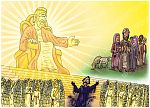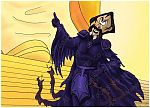Bible Cartoon: Job 01 - Job’s first test - Scene 02 - Disaster befalls Job
Click on Add to cart button below shopping cart.
Purchased Bible Cartoons do not have watermarks. Links to Cartoons provided on email once purchase is completed.Bible Book: Job
Bible Book Code: 1800101301
Scene no: 2 of 2
Bible Reference & Cartoon Description
Job 1:13-22 (NLT)
13 One day when Job’s sons and daughters were dining at the oldest brother’s house, 14 a messenger arrived at Job’s home with this news: “Your oxen were plowing, with the donkeys feeding beside them, 15 when the Sabeans raided us. They stole all the animals and killed all the farmhands. I am the only one who escaped to tell you.”
16 While he was still speaking, another messenger arrived with this news: “The fire of God has fallen from heaven and burned up your sheep and all the shepherds. I am the only one who escaped to tell you.”
17 While he was still speaking, a third messenger arrived with this news: “Three bands of Chaldean raiders have stolen your camels and killed your servants. I am the only one who escaped to tell you.”
18 While he was still speaking, another messenger arrived with this news: “Your sons and daughters were feasting in their oldest brother’s home. 19 Suddenly, a powerful wind swept in from the desert and hit the house on all sides. The house collapsed, and all your children are dead. I am the only one who escaped to tell you.”
20 Job stood up and tore his robe in grief. Then he shaved his head and fell to the ground before God.
21 He said,
“I came naked from my mother’s womb,
and I will be stripped of everything when I die.
The LORD gave me everything I had,
and the LORD has taken it away.
Praise the name of the LORD!”
22 In all of this, Job did not sin by blaming God.
DRAWING NOTES:
TIME OF DAY:
Unspecified in the Bible.
LIGHTING NOTES:
Sunlight from above illuminates these scenes.
CHARACTERS PRESENT:
Job in middle.
Servants running towards Job from each of the 4 scenes.
RESEARCH/ADDITIONAL NOTES:
This is an usual picture, in that I have split the “canvas” up into four corners, each illustrating one of the disasters that befell Job, which are recorded in verses 13-19. I decided to have a dominant colour in each of the four corner illustrations, which prevents too many clashing colours causing confusion, and unites the four corner illustrations into a whole.
Job himself is in the centre of the scene, tearing his expensive clothes in his grief.
The top left corner shows the description of verse 13-15, in which a Sabean raiding party “stole all the animals (in this case oxen & donkeys) and killed all the farmhands.” In fact I haven’t shown any donkeys in this picture, but you can see the Sabeans herding the Oxen away. The single servant/messenger who survived to tell Job about this disaster can be seen wearing a blue outer robe & running towards the central Job figure.
The top right corner shows the description of verse 16, in which “The fire of God has fallen from heaven and burned up your sheep and all the shepherds.” In fact we know that it was the Devil (Satan) who sent the fire. You can see the shepherds & some dead sheep on the ground, under the radiating flames from the “heavenly” fire. The single servant/messenger who survived to tell Job about this disaster can be seen wearing a green robe & running towards the central Job figure.
The bottom left corner shows the description of verse 17, in which “Three bands of Chaldean raiders have stolen your camels and killed your [Job’s] servants.” You can see the Chaldeans herding the camels away. The single servant/messenger who survived to tell Job about this disaster can be seen wearing brown/orange robes & running towards the central Job figure.
The bottom right corner shows the description of verse 18-19, in which “Your [Job’s] sons and daughters were feasting in their oldest brother’s home. Suddenly, a powerful wind swept in from the desert and hit the house on all sides. The house collapsed, and all your children are dead.” We know that it was the Devil (Satan) who sent the wind and caused Job’s children to be crushed inside the oldest brother’s house. You can see the tornado/wind storm howling across the landscape, with the rubble of the house below it. If you look carefully you may see a hand and foot sticking out from under the rubble!. The single servant/messenger who survived to tell Job about this disaster can be seen wearing blue/purple robes & running towards the central Job figure.
What is profound & rather amazing is that in all this suffering Job did not blame the Lord. In fact, verse 21 shows Job’s deep insight into the human condition: we come into the world with no physical thing, and we leave the world in the same condition. Regardless of what Job had, or didn’t have, he chose to worship the Lord.
Who were the Sabeans?
Of or relating to the ancient people and kingdom of Saba flourishing in southwestern Arabia from about 950 to 115 b.c. attaining their prime about the middle of the first millennium b.c. and anciently renowned for wealth and trade (as in spices)
[Source: https://www.merriam-webster.com/dictionary/Sabaean]
The only mention of the Sabeans in a warlike connection is in Job 1:15, where they are described as attacking and killing the servants of Job to rob them of cattle; but according to Joel iv. [A. V. iii.] 8, they dealt in slaves, including Jews. In the New Testament there is a reference to the kingdom of Sheba in the allusion to “the queen of the south” (Matt. xii. 42; Luke xi. 31). Sheba must be carefully distinguished from the Cushite or African Seba (comp. Gen. x. 7; I Chron. i. 9), as is shown by the discrimination between the “kings of Sheba and Seba” in Ps. lxxii. 10, and by the collocation of Egypt, Ethiopia, and Seba in Isa. xliii. 3, xlv. 14.
[Source: https://www.jewishencyclopedia.com/articles/12969-sabeans]
Who were the Chaldeans?
Chaldeans, Chalde’ans, or Chaldees’. It appears that the Chaldeans (Kaldai or Kaldi) were in the earliest times merely one out of many Cushite tribes inhabiting the great alluvial plain known afterwards as Chaldea or Babylonia. Their special seat was probably that southern portion of the country which is found to have so late retained the name of Chaldea. In process of time, as the Kaldi grew in power, their name gradually prevailed over those of the other tribes inhabiting the country; and by the era of the Jewish captivity it had begun to be used generally for all the inhabitants of Babylonia. It appears that while, both in Assyria and in later Babylonia, the Shemitic type of speech prevailed for civil purposes, the ancient Cushite dialect was retained, as a learned language for scientific and religious literature. This is no doubt the “learning” and the “tongue” to which reference it made in the book of Daniel, Dani 1:4 The Chaldeans were really the learned class; they were priests, magicians or astronomers, and in the last of the three capacities they probably effected discoveries of great importance. In later times they seem to have degenerated into mere fortune-tellers.
[Source: Smith’s Bible Dictionary]





